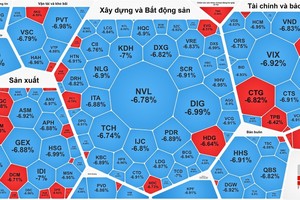 Farmers harvest dragon fruits. (Photo: SGGP)
Farmers harvest dragon fruits. (Photo: SGGP)
Mr. Nguyen Quoc Trinh, Chairman of the Dragon Fruit Association of Long An Province, on April 21, said that recently, the prices of dragon fruit had increased again after a long time of falling. Specifically, traders bought Grade-A red flesh dragon fruits at VND25,000 per kg (US$1.09) and Grade-B ones at VND20,000 per kg. At this price level, dragon fruit growers get good profits because the production cost is just over VND10,000 per kg ($0.43). Previously, the dragon fruit prices had fallen below VND10,000 per kg for a long time. Sometimes, prices even dropped to VND3,000 - VND5,000 per kg, causing farmers to suffer heavy losses.
According to Mr. Trinh, the prices of dragon fruit have recovered because the customs clearance of fruit products, including dragon fruit, into the Chinese market at the Northern border gates has been smooth and no longer been congested due to the Covid-19 pandemic as before. On the other hand, the Chinese market has been buying heavily this type of fruit. Meanwhile, farmers in Long An and Tien Giang provinces do not have many dragon fruits left to sell.
According to Mr. Trinh, the prices of dragon fruit have recovered because the customs clearance of fruit products, including dragon fruit, into the Chinese market at the Northern border gates has been smooth and no longer been congested due to the Covid-19 pandemic as before. On the other hand, the Chinese market has been buying heavily this type of fruit. Meanwhile, farmers in Long An and Tien Giang provinces do not have many dragon fruits left to sell.
 Farmers in Long An and Tien Giang provinces do not have many dragon fruits to sell. (Photo: SGGP)
Farmers in Long An and Tien Giang provinces do not have many dragon fruits to sell. (Photo: SGGP)
Ms. Dinh Thi Phuong Khanh, Deputy Director of the Department of Agriculture and Rural Development of Long An Province, said that the increase in the buying prices of dragon fruit is merely temporary and unstable because dragon fruit is mainly exported to China via cross-border trade, which is extremely risky. Once, there are disadvantaged fluctuations in the Chinese market, the dragon fruit prices will drop again, and growers will face difficulties. Currently, dragon fruit growing localities and relevant ministries are striving to support the gradual transition to the official export of dragon fruits into the Chinese market, at the same time, improve the quality of dragon fruits, expand the market to Europe and the US in order to reduce dependence on China.
 Despite the high prices, there are not many dragon fruits to sell. (Photo: SGGP)
Despite the high prices, there are not many dragon fruits to sell. (Photo: SGGP)
In Cho Gao District, Tien Giang Province, over the past time, due to the influence of the Covid-19 pandemic, dragon fruit cannot be exported, and the dragon fruit prices were extremely cheap, so many farmers neither took care of their orchards nor used artificial light to produce fruits. Therefore, up to this point, despite the high prices, there are not many dragon fruits to sell.
 Authorities advise farmers not to destroy dragon fruit plants, but to take good care and improve quality to expand export markets. (Photo: SGGP)
Authorities advise farmers not to destroy dragon fruit plants, but to take good care and improve quality to expand export markets. (Photo: SGGP)
Mr. Le Anh Thuy, Chairman of the People's Committee of Thanh Binh Commune in Cho Gao District of Tien Giang Province, said that the end of the dry season and the beginning of the rainy season is usually the off-season dragon fruit crop in the commune. In favorable years, about 900 dragon fruit growers in the commune use artificial light to produce off-season dragon fruits on about 600 hectares. Although the production cost is higher, the selling prices are also high, ensuring a profit for farmers. This year, due to the impact of the price drop in the previous months, very few growers produced the off-season dragon fruit crop, so at this time, just a few farmers still have dragon fruits to sell. Earlier, authorities advised farmers not to destroy dragon fruit plants, but to take good care and improve quality to expand export markets to stabilize production in the long run.
























